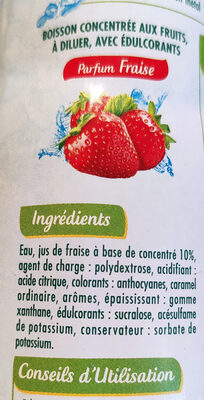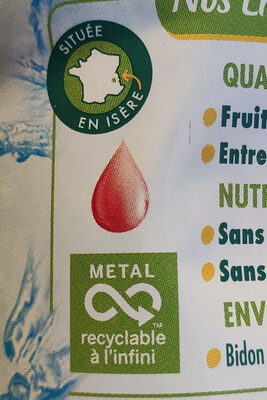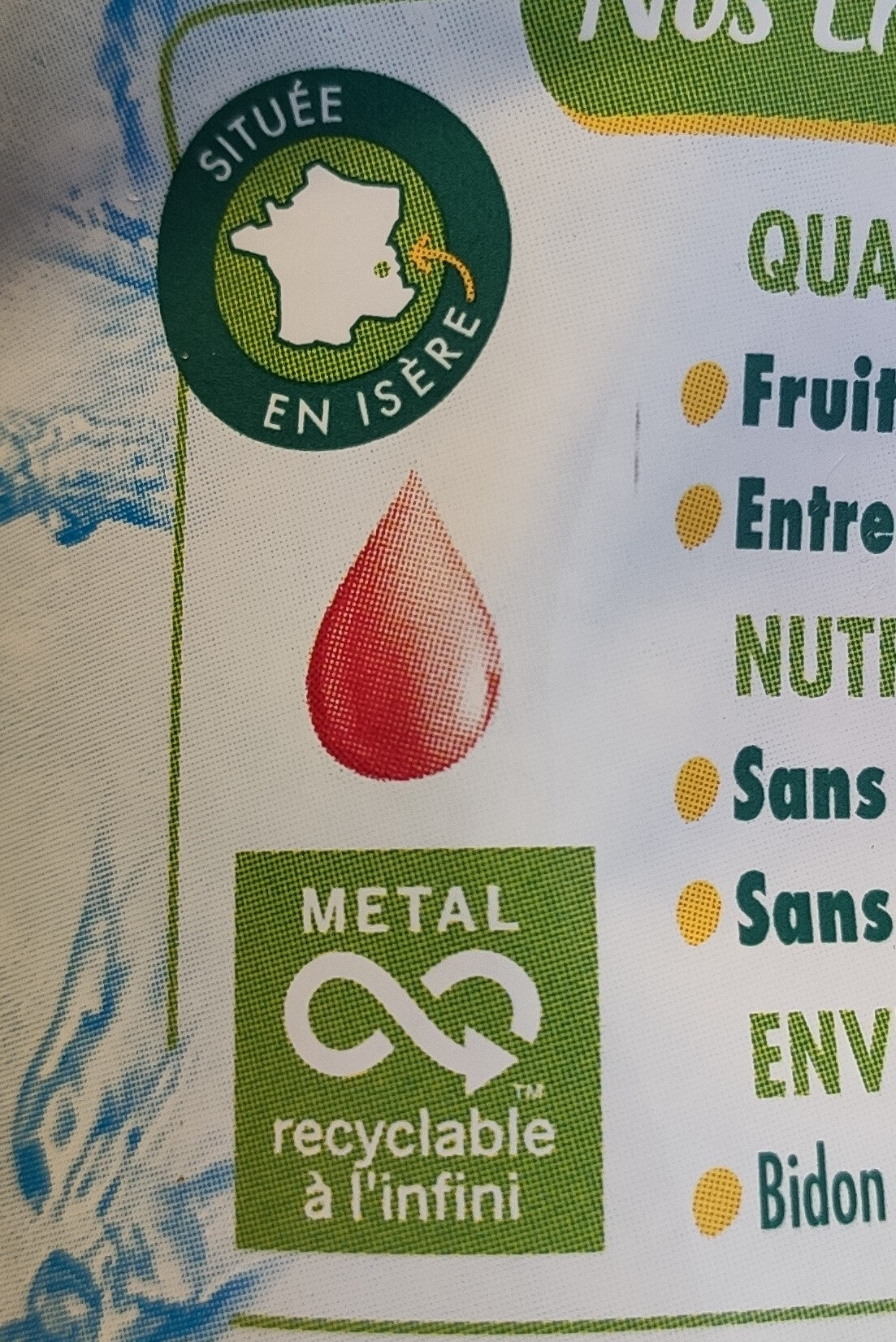Help us make food transparency the norm!
As a non-profit organization, we depend on your donations to continue informing consumers around the world about what they eat.
The food revolution starts with you!
Sirop Parfum fraise - Teisseire - 60 cl
Sirop Parfum fraise - Teisseire - 60 cl
This product page is not complete. You can help to complete it by editing it and adding more data from the photos we have, or by taking more photos using the app for Android or iPhone/iPad. Thank you!
×
Barcode: 3092718618209 (EAN / EAN-13)
Quantity: 60 cl
Packaging: fr:Bidon métal
Brands: Teisseire
Categories: Beverages, Syrups, Artificially sweetened beverages, Non-alcoholic beverages, Flavoured syrups, Strawberry syrups, Sugar-free flavoured syrups
Labels, certifications, awards:
Metal recycles forever
Manufacturing or processing places: France
Traceability code: EMB 222364 - Pludual (Côtes-d'Armor, France)
Link to the product page on the official site of the producer: http://teisseire.fr
Stores: carrefour.fr
Countries where sold: France
Matching with your preferences
Health
Ingredients
-
17 ingredients
: Eau, jus de fraise à base de concentré 10%, agent de charge: polydextrose, acidifiant : acide citrique, colorants : anthocyanes, caramel (E150a), arômes, épaississant : gomme xanthane, édulcorants: sucralose, acésulfame K, conservateur: sorbate de potassium.
Food processing
-
Ultra processed foods
Elements that indicate the product is in the 4 - Ultra processed food and drink products group:
- Additive: E150a - Plain caramel
- Additive: E163 - Anthocyanins
- Additive: E415 - Xanthan gum
- Additive: E950 - Acesulfame k
- Additive: E955 - Sucralose
- Ingredient: Bulking agent
- Ingredient: Colour
- Ingredient: Flavouring
- Ingredient: Sweetener
- Ingredient: Thickener
Food products are classified into 4 groups according to their degree of processing:
- Unprocessed or minimally processed foods
- Processed culinary ingredients
- Processed foods
- Ultra processed foods
The determination of the group is based on the category of the product and on the ingredients it contains.
Additives
-
E1200 - Polydextrose
Polydextrose: Polydextrose is a synthetic polymer of glucose. It is a food ingredient classified as soluble fiber by the U.S. Food and Drug Administration -FDA- as well as Health Canada, as of April 2013. It is frequently used to increase the dietary fiber content of food, to replace sugar, and to reduce calories and fat content. It is a multi-purpose food ingredient synthesized from dextrose -glucose-, plus about 10 percent sorbitol and 1 percent citric acid. Its E number is E1200. The FDA approved it in 1981. It is 0.1 times as sweet as sugar.Source: Wikipedia
-
E163 - Anthocyanins
Anthocyanin: Anthocyanins -also anthocyans; from Greek: ἄνθος -anthos- "flower" and κυάνεος/κυανοῦς kyaneos/kyanous "dark blue"- are water-soluble vacuolar pigments that, depending on their pH, may appear red, purple, or blue. Food plants rich in anthocyanins include the blueberry, raspberry, black rice, and black soybean, among many others that are red, blue, purple, or black. Some of the colors of autumn leaves are derived from anthocyanins.Anthocyanins belong to a parent class of molecules called flavonoids synthesized via the phenylpropanoid pathway. They occur in all tissues of higher plants, including leaves, stems, roots, flowers, and fruits. Anthocyanins are derived from anthocyanidins by adding sugars. They are odorless and moderately astringent. Although approved to color foods and beverages in the European Union, anthocyanins are not approved for use as a food additive because they have not been verified as safe when used as food or supplement ingredients. There is no conclusive evidence anthocyanins have any effect on human biology or diseases.Source: Wikipedia
-
E202 - Potassium sorbate
Potassium sorbate (E202) is a synthetic food preservative commonly used to extend the shelf life of various food products.
It works by inhibiting the growth of molds, yeast, and some bacteria, preventing spoilage. When added to foods, it helps maintain their freshness and quality.
Some studies have shown that when combined with nitrites, potassium sorbate have genotoxic activity in vitro. However, potassium sorbate is generally recognized as safe (GRAS) by regulatory authorities.
-
E330 - Citric acid
Citric acid is a natural organic acid found in citrus fruits such as lemons, oranges, and limes.
It is widely used in the food industry as a flavor enhancer, acidulant, and preservative due to its tart and refreshing taste.
Citric acid is safe for consumption when used in moderation and is considered a generally recognized as safe (GRAS) food additive by regulatory agencies worldwide.
-
E415 - Xanthan gum
Xanthan gum (E415) is a natural polysaccharide derived from fermented sugars, often used in the food industry as a thickening and stabilizing agent.
This versatile food additive enhances texture and prevents ingredient separation in a wide range of products, including salad dressings, sauces, and gluten-free baked goods.
It is considered safe for consumption even at high intake amounts.
-
E950 - Acesulfame k
Acesulfame potassium: Acesulfame potassium - AY-see-SUL-faym-, also known as acesulfame K -K is the symbol for potassium- or Ace K, is a calorie-free sugar substitute -artificial sweetener- often marketed under the trade names Sunett and Sweet One. In the European Union, it is known under the E number -additive code- E950. It was discovered accidentally in 1967 by German chemist Karl Clauss at Hoechst AG -now Nutrinova-. In chemical structure, acesulfame potassium is the potassium salt of 6-methyl-1‚2,3-oxathiazine-4-3H--one 2‚2-dioxide. It is a white crystalline powder with molecular formula C4H4KNO4S and a molecular weight of 201.24 g/mol.Source: Wikipedia
-
E955 - Sucralose
Sucralose: Sucralose is an artificial sweetener and sugar substitute. The majority of ingested sucralose is not broken down by the body, so it is noncaloric. In the European Union, it is also known under the E number E955. It is produced by chlorination of sucrose. Sucralose is about 320 to 1‚000 times sweeter than sucrose, three times as sweet as both aspartame and acesulfame potassium, and twice as sweet as sodium saccharin. Evidence of benefit is lacking for long-term weight loss with some data supporting weight gain and heart disease risks.It is stable under heat and over a broad range of pH conditions. Therefore, it can be used in baking or in products that require a long shelf life. The commercial success of sucralose-based products stems from its favorable comparison to other low-calorie sweeteners in terms of taste, stability, and safety. Common brand names of sucralose-based sweeteners are Splenda, Zerocal, Sukrana, SucraPlus, Candys, Cukren, and Nevella. Canderel Yellow also contains sucralose, but the original Canderel and Green Canderel do not.Source: Wikipedia
Ingredients analysis
-
Palm oil free
No ingredients containing palm oil detected
-
Maybe vegan
Ingredients that may not be vegan: Flavouring
-
Maybe vegetarian
Ingredients that may not be vegetarian: Flavouring
-
Details of the analysis of the ingredients
: Eau, jus de fraise à base de concentré 10%, agent de charge (polydextrose), acidifiant (acide citrique), colorants (anthocyanes), e150a, arômes, épaississant (gomme xanthane), édulcorants (sucralose), acésulfame K, conservateur (sorbate de potassium)- Eau -> en:water - vegan: yes - vegetarian: yes - ciqual_food_code: 18066 - percent_min: 25 - percent_max: 90
- jus de fraise à base de concentré -> en:strawberry-juice-from-concentrate - vegan: yes - vegetarian: yes - ciqual_food_code: 13014 - percent_min: 10 - percent: 10 - percent_max: 10
- agent de charge -> en:bulking-agent - percent_min: 0 - percent_max: 10
- polydextrose -> en:e1200 - vegan: yes - vegetarian: yes - percent_min: 0 - percent_max: 10
- acidifiant -> en:acid - percent_min: 0 - percent_max: 10
- acide citrique -> en:e330 - vegan: yes - vegetarian: yes - percent_min: 0 - percent_max: 10
- colorants -> en:colour - percent_min: 0 - percent_max: 10
- anthocyanes -> en:e163 - vegan: yes - vegetarian: yes - percent_min: 0 - percent_max: 10
- e150a -> en:e150a - vegan: yes - vegetarian: yes - percent_min: 0 - percent_max: 10
- arômes -> en:flavouring - vegan: maybe - vegetarian: maybe - percent_min: 0 - percent_max: 5
- épaississant -> en:thickener - percent_min: 0 - percent_max: 5
- gomme xanthane -> en:e415 - vegan: yes - vegetarian: yes - percent_min: 0 - percent_max: 5
- édulcorants -> en:sweetener - percent_min: 0 - percent_max: 5
- sucralose -> en:e955 - vegan: yes - vegetarian: yes - percent_min: 0 - percent_max: 5
- acésulfame K -> en:e950 - vegan: yes - vegetarian: yes - percent_min: 0 - percent_max: 5
- conservateur -> en:preservative - percent_min: 0 - percent_max: 5
- sorbate de potassium -> en:e202 - vegan: yes - vegetarian: yes - percent_min: 0 - percent_max: 5
Nutrition
-
Average nutritional quality
⚠ ️Warning: the amount of fruits, vegetables and nuts is not specified, their possible positive contribution to the grade could not be taken into account.This product is considered a beverage for the calculation of the Nutri-Score.
Positive points: 0
- Proteins: 0 / 5 (value: 0, rounded value: 0)
- Fiber: 0 / 5 (value: 0, rounded value: 0)
- Fruits, vegetables, nuts, and colza/walnut/olive oils: 0 / 10 (value: 0, rounded value: 0)
Negative points: 2
- Energy: 1 / 10 (value: 6, rounded value: 6)
- Sugars: 1 / 10 (value: 0.5, rounded value: 0.5)
- Saturated fat: 0 / 10 (value: 0, rounded value: 0)
- Sodium: 0 / 10 (value: 4, rounded value: 4)
The points for proteins are counted because the negative points are less than 11.
Nutritional score: (2 - 0)
Nutri-Score:
-
Nutrient levels
-
Fat in low quantity (0%)
What you need to know- A high consumption of fat, especially saturated fats, can raise cholesterol, which increases the risk of heart diseases.
Recommendation: Limit the consumption of fat and saturated fat- Choose products with lower fat and saturated fat content.
-
Saturated fat in low quantity (0%)
What you need to know- A high consumption of fat, especially saturated fats, can raise cholesterol, which increases the risk of heart diseases.
Recommendation: Limit the consumption of fat and saturated fat- Choose products with lower fat and saturated fat content.
-
Sugars in low quantity (0.5%)
What you need to know- A high consumption of sugar can cause weight gain and tooth decay. It also augments the risk of type 2 diabetes and cardio-vascular diseases.
Recommendation: Limit the consumption of sugar and sugary drinks- Sugary drinks (such as sodas, fruit beverages, and fruit juices and nectars) should be limited as much as possible (no more than 1 glass a day).
- Choose products with lower sugar content and reduce the consumption of products with added sugars.
-
Salt in low quantity (0.01%)
What you need to know- A high consumption of salt (or sodium) can cause raised blood pressure, which can increase the risk of heart disease and stroke.
- Many people who have high blood pressure do not know it, as there are often no symptoms.
- Most people consume too much salt (on average 9 to 12 grams per day), around twice the recommended maximum level of intake.
Recommendation: Limit the consumption of salt and salted food- Reduce the quantity of salt used when cooking, and don't salt again at the table.
- Limit the consumption of salty snacks and choose products with lower salt content.
-
-
Nutrition facts
Nutrition facts As sold
for 100 g / 100 mlPrepared
for 100 g / 100 mlCompared to: Sugar-free flavoured syrups Energy 83 kj
(23 kcal)6 kj
(2 kcal)+43% Fat 0 g 0 g -100% Saturated fat 0 g 0 g -100% Carbohydrates 2.2 g < 0.5 g +28% Sugars 1.9 g < 0.5 g +230% Fiber ? - Proteins 0 g 0 g -100% Salt 0.03 g < 0.01 g -38% Fruits‚ vegetables‚ nuts and rapeseed‚ walnut and olive oils (estimate from ingredients list analysis) 10 % ?
Environment
-
Eco-Score A - Very low environmental impact
⚠ ️Select a country in order to include the full impact of transportation.The Eco-Score is an experimental score that summarizes the environmental impacts of food products.→ The Eco-Score was initially developped for France and it is being extended to other European countries. The Eco-Score formula is subject to change as it is regularly improved to make it more precise and better suited to each country.Life cycle analysis
-
Average impact of products of the same category: A (Score: 100/100)
Category: Syrup (mint, strawberries flavouredetc.), with sugar diluted in water
Category: Syrup (mint, strawberries flavouredetc.), with sugar diluted in water
- PEF environmental score: 0.02 (the lower the score, the lower the impact)
- including impact on climate change: 0.10 kg CO2 eq/kg of product
Stage Impact Agriculture
53.2 %Processing
7.4 %Packaging
27.4 %Transportation
7.4 %Distribution
3.2 %Consumption
1.4 %
Bonuses and maluses
-
Missing origins of ingredients information
Malus: -5
⚠ ️ The origins of the ingredients of this product are not indicated.
If they are indicated on the packaging, you can modify the product sheet and add them.
If you are the manufacturer of this product, you can send us the information with our free platform for producers.
-
Packaging with a medium impact
Malus: -10
Shape Material Recycling Impact Jug Metal High ⚠ ️ The information about the packaging of this product is not sufficiently precise (exact shapes and materials of all components of the packaging).⚠ ️ For a more precise calculation of the Eco-Score, you can modify the product page and add them.
If you are the manufacturer of this product, you can send us the information with our free platform for producers.
Eco-Score for this product
-
Impact for this product: A (Score: 85/100)
Product: Sirop Parfum fraise - Teisseire - 60 cl
Life cycle analysis score: 100
Sum of bonuses and maluses: -15
Final score: 85/100
-
Carbon footprint
-
Equal to driving 0.1 km in a petrol car
10 g CO² per 100g of product
The carbon emission figure comes from ADEME's Agribalyse database, for the category: Syrup (mint, strawberries flavouredetc.), with sugar diluted in water (Source: ADEME Agribalyse Database)
Stage Impact Agriculture
33.0 %Processing
19.9 %Packaging
26.0 %Transportation
18.6 %Distribution
2.2 %Consumption
0.3 %
Packaging
-
Packaging with a medium impact
-
Packaging parts
Jug (Metal)
-
Packaging materials
Material % Packaging weight Packaging weight per 100 g of product Metal
-
Transportation
-
Origins of ingredients
Missing origins of ingredients information
⚠ ️ The origins of the ingredients of this product are not indicated.
If they are indicated on the packaging, you can modify the product sheet and add them.
If you are the manufacturer of this product, you can send us the information with our free platform for producers.Add the origins of ingredients for this product Add the origins of ingredients for this product
Report a problem
-
Incomplete or incorrect information?
Category, labels, ingredients, allergens, nutritional information, photos etc.
If the information does not match the information on the packaging, please complete or correct it. Open Food Facts is a collaborative database, and every contribution is useful for all.
Data sources
Product added on by kiliweb
Last edit of product page on by benbenben.
Product page also edited by alex-off, charlesnepote, dariodu59, driveoff, feat, g123k, julie-yuka, openfoodfacts-contributors, oye, packbot, quechoisir, quentinbrd, teolemon, yuka.YUt3RURLTUJoc0VEaXZZajdqVGMzZnQ0bUllb1UyL29OUFkrSUE9PQ, yuka.sY2b0xO6T85zoF3NwEKvlhBHedPy_QrNF0f4sHTUx9GVFa6yZfFc86j3bao, yuka.sY2b0xO6T85zoF3NwEKvlnAbWNWEnDydJyTvmUKC29mecKCyRIxs-IL1Fas.











